A Study on Harrods: Training's Impact on Employee Satisfaction
VerifiedAdded on 2023/06/18
|14
|4272
|109
Report
AI Summary
This report explores the impact of training and development practices on employee satisfaction within Harrods, a prominent retail company. It addresses the research question of how training and development initiatives affect employee satisfaction, aiming to provide recommendations for enhancing satisfaction and reducing employee turnover. The report reviews existing literature on training and development, employee satisfaction, and their interconnectedness, highlighting both the benefits and potential drawbacks of training programs. It also discusses the importance of employee satisfaction for retention and organizational performance. A descriptive research design is employed, utilizing a research onion model to guide the methodological approach. The analysis seeks to provide insights into how Harrods can optimize its training programs to improve employee morale, skills, and overall job satisfaction, ultimately contributing to the company's success.

RESEARCH
METHODOLOGIES
METHODOLOGIES
Paraphrase This Document
Need a fresh take? Get an instant paraphrase of this document with our AI Paraphraser
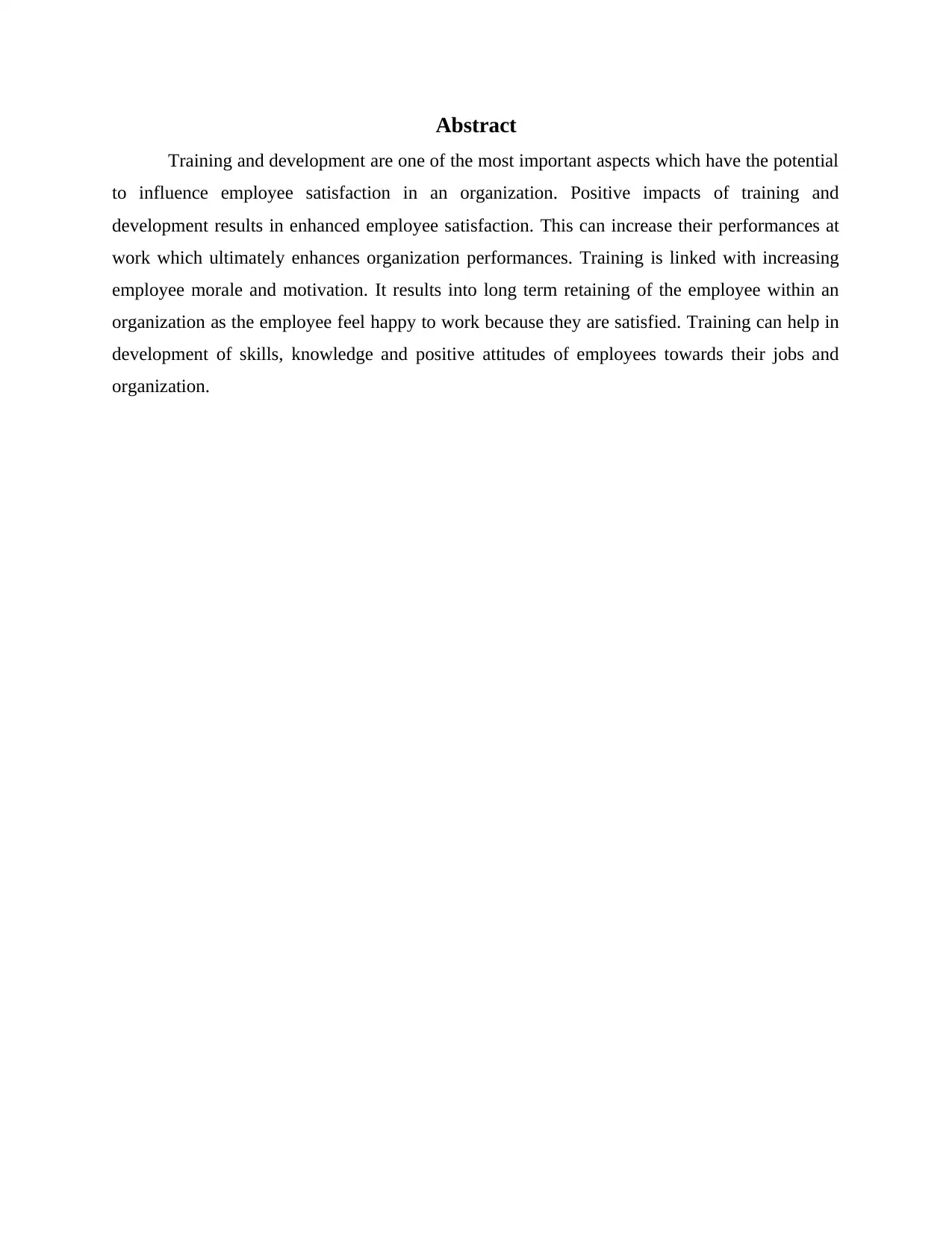
Abstract
Training and development are one of the most important aspects which have the potential
to influence employee satisfaction in an organization. Positive impacts of training and
development results in enhanced employee satisfaction. This can increase their performances at
work which ultimately enhances organization performances. Training is linked with increasing
employee morale and motivation. It results into long term retaining of the employee within an
organization as the employee feel happy to work because they are satisfied. Training can help in
development of skills, knowledge and positive attitudes of employees towards their jobs and
organization.
Training and development are one of the most important aspects which have the potential
to influence employee satisfaction in an organization. Positive impacts of training and
development results in enhanced employee satisfaction. This can increase their performances at
work which ultimately enhances organization performances. Training is linked with increasing
employee morale and motivation. It results into long term retaining of the employee within an
organization as the employee feel happy to work because they are satisfied. Training can help in
development of skills, knowledge and positive attitudes of employees towards their jobs and
organization.
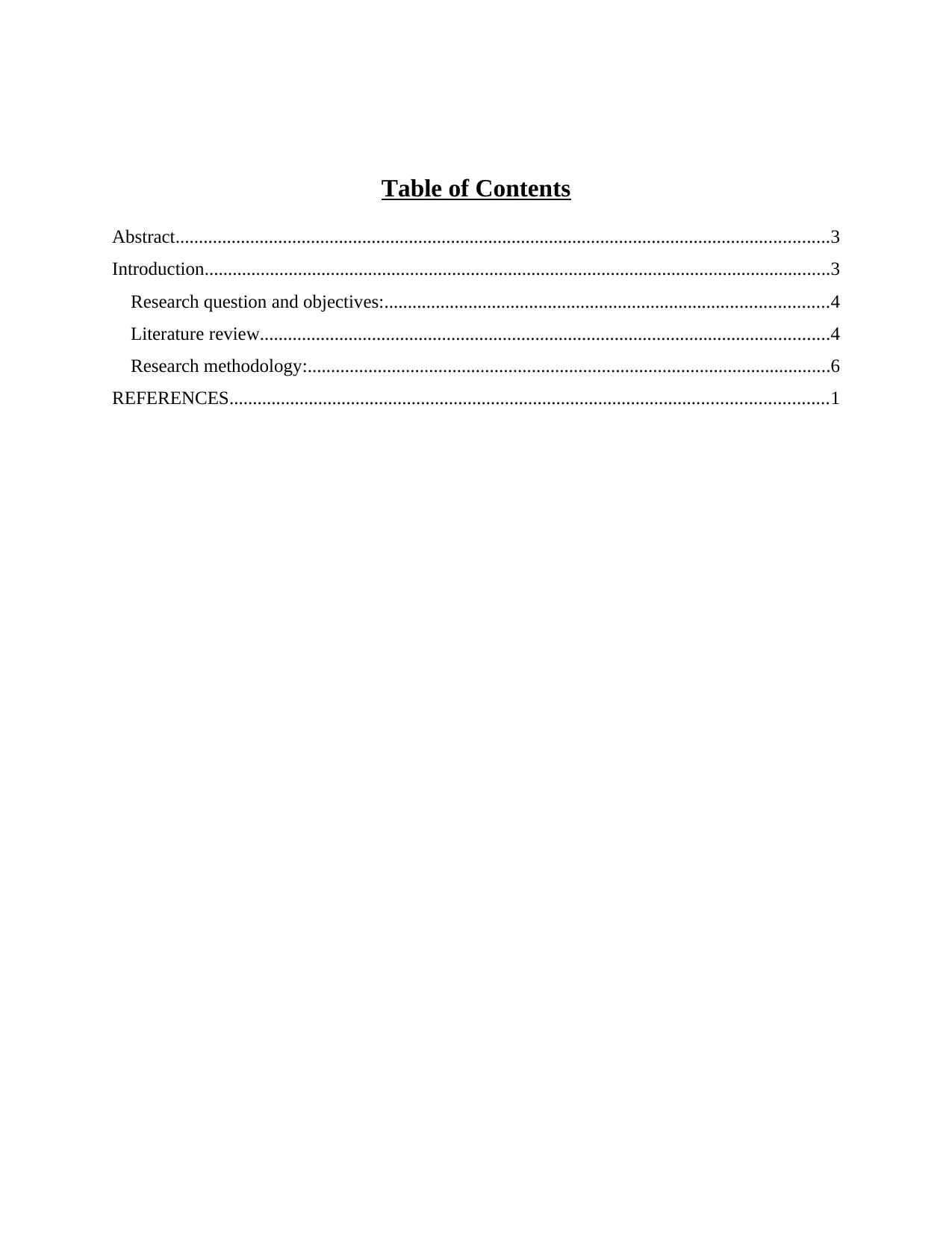
Table of Contents
Abstract............................................................................................................................................3
Introduction......................................................................................................................................3
Research question and objectives:...............................................................................................4
Literature review..........................................................................................................................4
Research methodology:................................................................................................................6
REFERENCES................................................................................................................................1
Abstract............................................................................................................................................3
Introduction......................................................................................................................................3
Research question and objectives:...............................................................................................4
Literature review..........................................................................................................................4
Research methodology:................................................................................................................6
REFERENCES................................................................................................................................1
⊘ This is a preview!⊘
Do you want full access?
Subscribe today to unlock all pages.

Trusted by 1+ million students worldwide
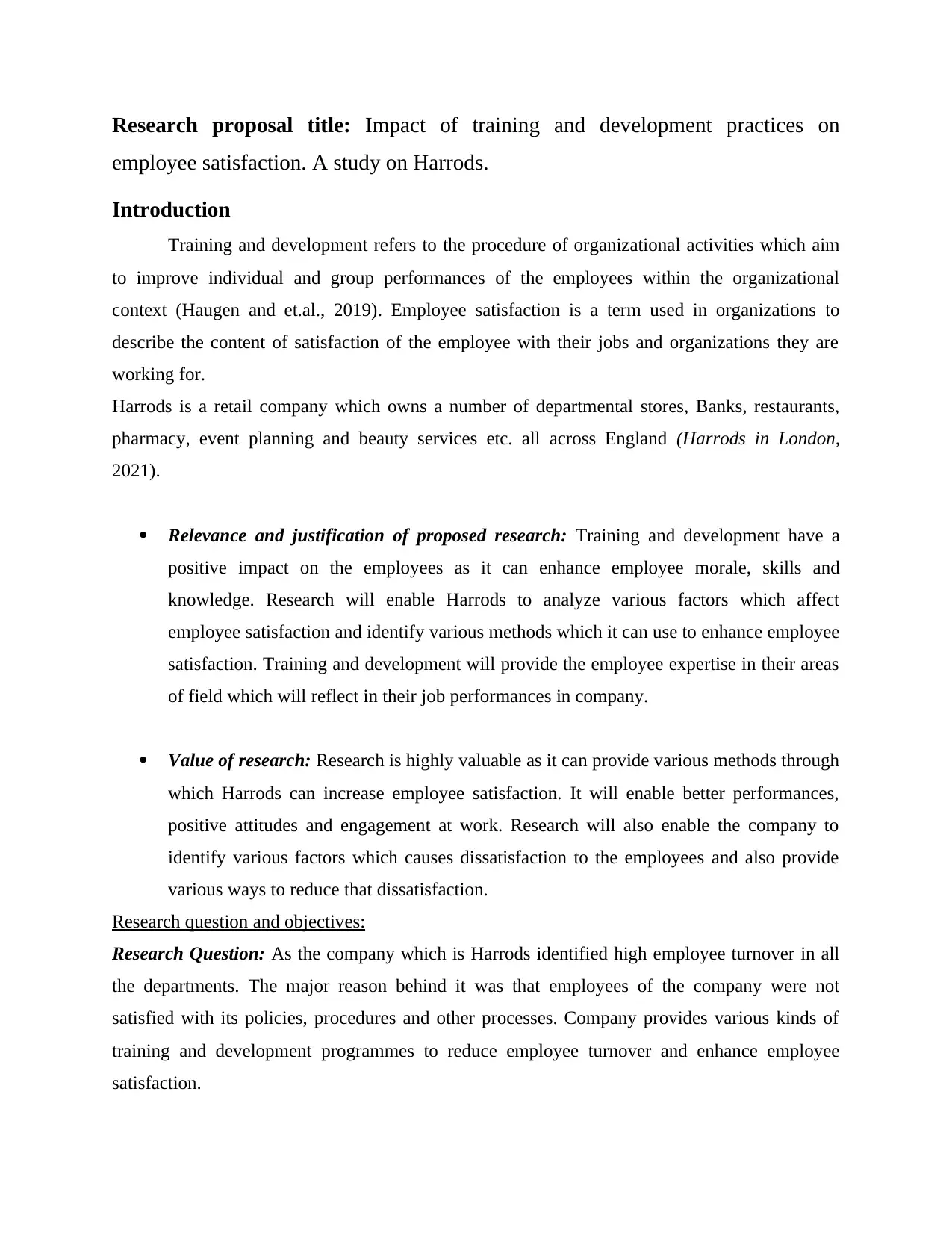
Research proposal title: Impact of training and development practices on
employee satisfaction. A study on Harrods.
Introduction
Training and development refers to the procedure of organizational activities which aim
to improve individual and group performances of the employees within the organizational
context (Haugen and et.al., 2019). Employee satisfaction is a term used in organizations to
describe the content of satisfaction of the employee with their jobs and organizations they are
working for.
Harrods is a retail company which owns a number of departmental stores, Banks, restaurants,
pharmacy, event planning and beauty services etc. all across England (Harrods in London,
2021).
Relevance and justification of proposed research: Training and development have a
positive impact on the employees as it can enhance employee morale, skills and
knowledge. Research will enable Harrods to analyze various factors which affect
employee satisfaction and identify various methods which it can use to enhance employee
satisfaction. Training and development will provide the employee expertise in their areas
of field which will reflect in their job performances in company.
Value of research: Research is highly valuable as it can provide various methods through
which Harrods can increase employee satisfaction. It will enable better performances,
positive attitudes and engagement at work. Research will also enable the company to
identify various factors which causes dissatisfaction to the employees and also provide
various ways to reduce that dissatisfaction.
Research question and objectives:
Research Question: As the company which is Harrods identified high employee turnover in all
the departments. The major reason behind it was that employees of the company were not
satisfied with its policies, procedures and other processes. Company provides various kinds of
training and development programmes to reduce employee turnover and enhance employee
satisfaction.
employee satisfaction. A study on Harrods.
Introduction
Training and development refers to the procedure of organizational activities which aim
to improve individual and group performances of the employees within the organizational
context (Haugen and et.al., 2019). Employee satisfaction is a term used in organizations to
describe the content of satisfaction of the employee with their jobs and organizations they are
working for.
Harrods is a retail company which owns a number of departmental stores, Banks, restaurants,
pharmacy, event planning and beauty services etc. all across England (Harrods in London,
2021).
Relevance and justification of proposed research: Training and development have a
positive impact on the employees as it can enhance employee morale, skills and
knowledge. Research will enable Harrods to analyze various factors which affect
employee satisfaction and identify various methods which it can use to enhance employee
satisfaction. Training and development will provide the employee expertise in their areas
of field which will reflect in their job performances in company.
Value of research: Research is highly valuable as it can provide various methods through
which Harrods can increase employee satisfaction. It will enable better performances,
positive attitudes and engagement at work. Research will also enable the company to
identify various factors which causes dissatisfaction to the employees and also provide
various ways to reduce that dissatisfaction.
Research question and objectives:
Research Question: As the company which is Harrods identified high employee turnover in all
the departments. The major reason behind it was that employees of the company were not
satisfied with its policies, procedures and other processes. Company provides various kinds of
training and development programmes to reduce employee turnover and enhance employee
satisfaction.
Paraphrase This Document
Need a fresh take? Get an instant paraphrase of this document with our AI Paraphraser
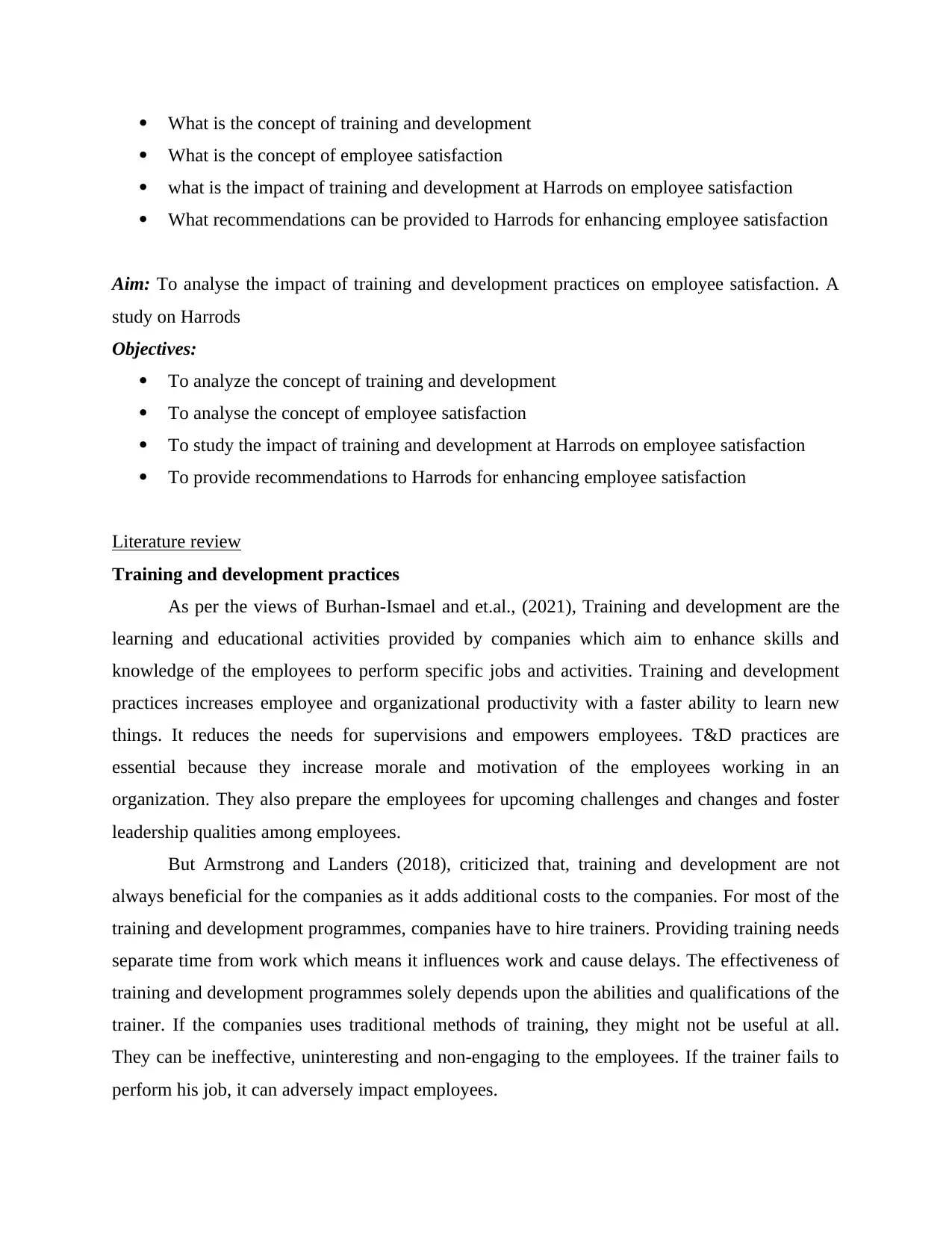
What is the concept of training and development
What is the concept of employee satisfaction
what is the impact of training and development at Harrods on employee satisfaction
What recommendations can be provided to Harrods for enhancing employee satisfaction
Aim: To analyse the impact of training and development practices on employee satisfaction. A
study on Harrods
Objectives:
To analyze the concept of training and development
To analyse the concept of employee satisfaction
To study the impact of training and development at Harrods on employee satisfaction
To provide recommendations to Harrods for enhancing employee satisfaction
Literature review
Training and development practices
As per the views of Burhan-Ismael and et.al., (2021), Training and development are the
learning and educational activities provided by companies which aim to enhance skills and
knowledge of the employees to perform specific jobs and activities. Training and development
practices increases employee and organizational productivity with a faster ability to learn new
things. It reduces the needs for supervisions and empowers employees. T&D practices are
essential because they increase morale and motivation of the employees working in an
organization. They also prepare the employees for upcoming challenges and changes and foster
leadership qualities among employees.
But Armstrong and Landers (2018), criticized that, training and development are not
always beneficial for the companies as it adds additional costs to the companies. For most of the
training and development programmes, companies have to hire trainers. Providing training needs
separate time from work which means it influences work and cause delays. The effectiveness of
training and development programmes solely depends upon the abilities and qualifications of the
trainer. If the companies uses traditional methods of training, they might not be useful at all.
They can be ineffective, uninteresting and non-engaging to the employees. If the trainer fails to
perform his job, it can adversely impact employees.
What is the concept of employee satisfaction
what is the impact of training and development at Harrods on employee satisfaction
What recommendations can be provided to Harrods for enhancing employee satisfaction
Aim: To analyse the impact of training and development practices on employee satisfaction. A
study on Harrods
Objectives:
To analyze the concept of training and development
To analyse the concept of employee satisfaction
To study the impact of training and development at Harrods on employee satisfaction
To provide recommendations to Harrods for enhancing employee satisfaction
Literature review
Training and development practices
As per the views of Burhan-Ismael and et.al., (2021), Training and development are the
learning and educational activities provided by companies which aim to enhance skills and
knowledge of the employees to perform specific jobs and activities. Training and development
practices increases employee and organizational productivity with a faster ability to learn new
things. It reduces the needs for supervisions and empowers employees. T&D practices are
essential because they increase morale and motivation of the employees working in an
organization. They also prepare the employees for upcoming challenges and changes and foster
leadership qualities among employees.
But Armstrong and Landers (2018), criticized that, training and development are not
always beneficial for the companies as it adds additional costs to the companies. For most of the
training and development programmes, companies have to hire trainers. Providing training needs
separate time from work which means it influences work and cause delays. The effectiveness of
training and development programmes solely depends upon the abilities and qualifications of the
trainer. If the companies uses traditional methods of training, they might not be useful at all.
They can be ineffective, uninteresting and non-engaging to the employees. If the trainer fails to
perform his job, it can adversely impact employees.
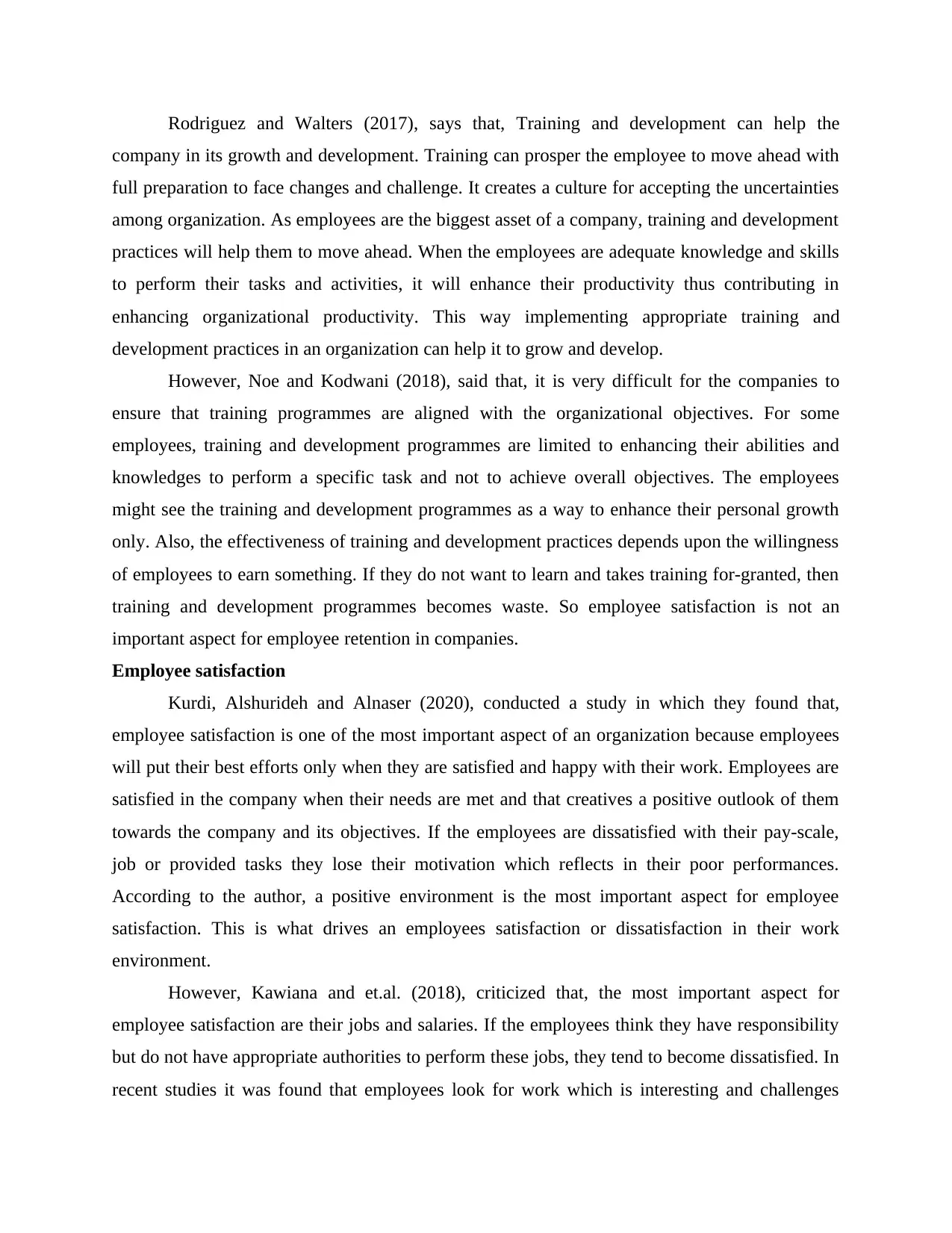
Rodriguez and Walters (2017), says that, Training and development can help the
company in its growth and development. Training can prosper the employee to move ahead with
full preparation to face changes and challenge. It creates a culture for accepting the uncertainties
among organization. As employees are the biggest asset of a company, training and development
practices will help them to move ahead. When the employees are adequate knowledge and skills
to perform their tasks and activities, it will enhance their productivity thus contributing in
enhancing organizational productivity. This way implementing appropriate training and
development practices in an organization can help it to grow and develop.
However, Noe and Kodwani (2018), said that, it is very difficult for the companies to
ensure that training programmes are aligned with the organizational objectives. For some
employees, training and development programmes are limited to enhancing their abilities and
knowledges to perform a specific task and not to achieve overall objectives. The employees
might see the training and development programmes as a way to enhance their personal growth
only. Also, the effectiveness of training and development practices depends upon the willingness
of employees to earn something. If they do not want to learn and takes training for-granted, then
training and development programmes becomes waste. So employee satisfaction is not an
important aspect for employee retention in companies.
Employee satisfaction
Kurdi, Alshurideh and Alnaser (2020), conducted a study in which they found that,
employee satisfaction is one of the most important aspect of an organization because employees
will put their best efforts only when they are satisfied and happy with their work. Employees are
satisfied in the company when their needs are met and that creatives a positive outlook of them
towards the company and its objectives. If the employees are dissatisfied with their pay-scale,
job or provided tasks they lose their motivation which reflects in their poor performances.
According to the author, a positive environment is the most important aspect for employee
satisfaction. This is what drives an employees satisfaction or dissatisfaction in their work
environment.
However, Kawiana and et.al. (2018), criticized that, the most important aspect for
employee satisfaction are their jobs and salaries. If the employees think they have responsibility
but do not have appropriate authorities to perform these jobs, they tend to become dissatisfied. In
recent studies it was found that employees look for work which is interesting and challenges
company in its growth and development. Training can prosper the employee to move ahead with
full preparation to face changes and challenge. It creates a culture for accepting the uncertainties
among organization. As employees are the biggest asset of a company, training and development
practices will help them to move ahead. When the employees are adequate knowledge and skills
to perform their tasks and activities, it will enhance their productivity thus contributing in
enhancing organizational productivity. This way implementing appropriate training and
development practices in an organization can help it to grow and develop.
However, Noe and Kodwani (2018), said that, it is very difficult for the companies to
ensure that training programmes are aligned with the organizational objectives. For some
employees, training and development programmes are limited to enhancing their abilities and
knowledges to perform a specific task and not to achieve overall objectives. The employees
might see the training and development programmes as a way to enhance their personal growth
only. Also, the effectiveness of training and development practices depends upon the willingness
of employees to earn something. If they do not want to learn and takes training for-granted, then
training and development programmes becomes waste. So employee satisfaction is not an
important aspect for employee retention in companies.
Employee satisfaction
Kurdi, Alshurideh and Alnaser (2020), conducted a study in which they found that,
employee satisfaction is one of the most important aspect of an organization because employees
will put their best efforts only when they are satisfied and happy with their work. Employees are
satisfied in the company when their needs are met and that creatives a positive outlook of them
towards the company and its objectives. If the employees are dissatisfied with their pay-scale,
job or provided tasks they lose their motivation which reflects in their poor performances.
According to the author, a positive environment is the most important aspect for employee
satisfaction. This is what drives an employees satisfaction or dissatisfaction in their work
environment.
However, Kawiana and et.al. (2018), criticized that, the most important aspect for
employee satisfaction are their jobs and salaries. If the employees think they have responsibility
but do not have appropriate authorities to perform these jobs, they tend to become dissatisfied. In
recent studies it was found that employees look for work which is interesting and challenges
⊘ This is a preview!⊘
Do you want full access?
Subscribe today to unlock all pages.

Trusted by 1+ million students worldwide
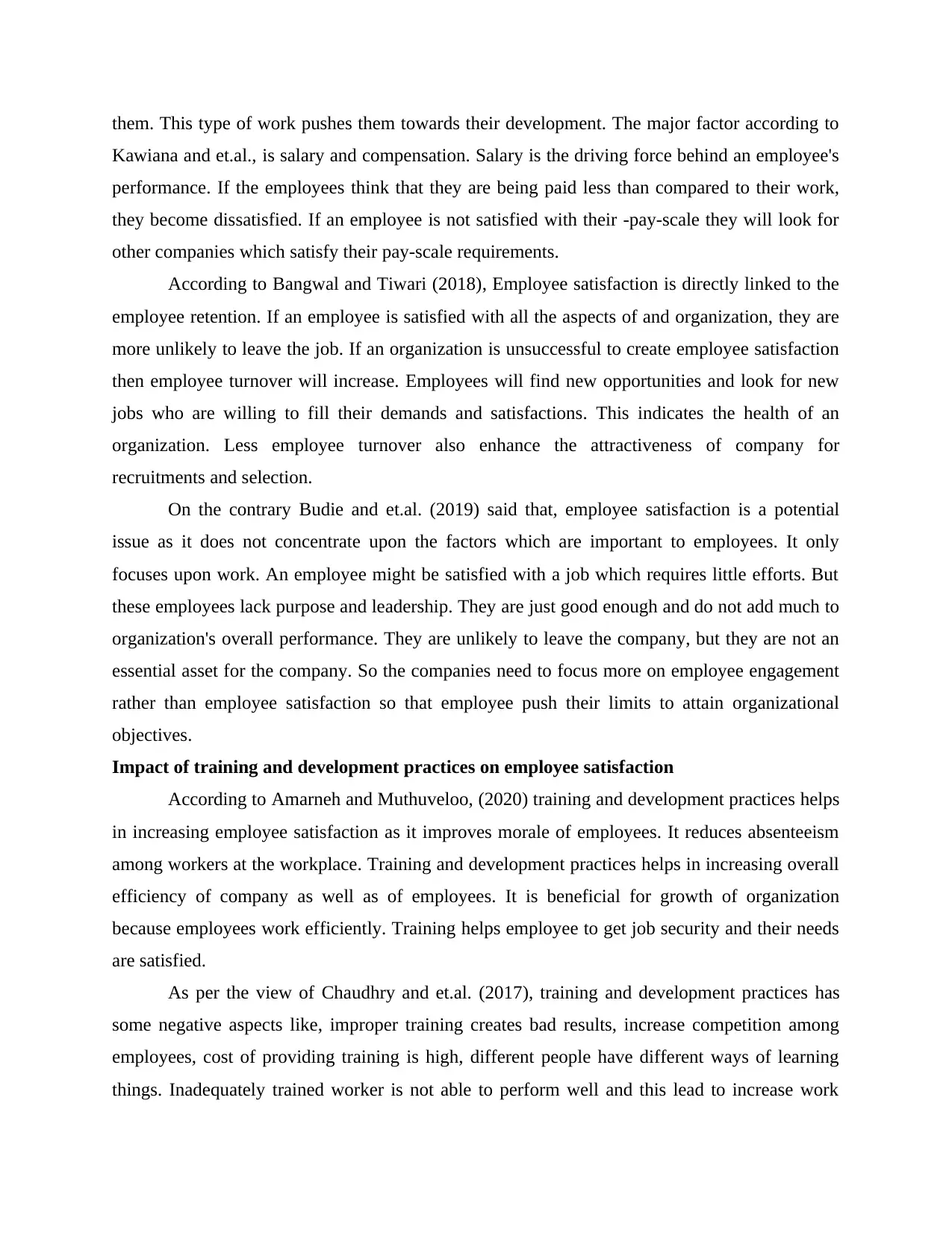
them. This type of work pushes them towards their development. The major factor according to
Kawiana and et.al., is salary and compensation. Salary is the driving force behind an employee's
performance. If the employees think that they are being paid less than compared to their work,
they become dissatisfied. If an employee is not satisfied with their -pay-scale they will look for
other companies which satisfy their pay-scale requirements.
According to Bangwal and Tiwari (2018), Employee satisfaction is directly linked to the
employee retention. If an employee is satisfied with all the aspects of and organization, they are
more unlikely to leave the job. If an organization is unsuccessful to create employee satisfaction
then employee turnover will increase. Employees will find new opportunities and look for new
jobs who are willing to fill their demands and satisfactions. This indicates the health of an
organization. Less employee turnover also enhance the attractiveness of company for
recruitments and selection.
On the contrary Budie and et.al. (2019) said that, employee satisfaction is a potential
issue as it does not concentrate upon the factors which are important to employees. It only
focuses upon work. An employee might be satisfied with a job which requires little efforts. But
these employees lack purpose and leadership. They are just good enough and do not add much to
organization's overall performance. They are unlikely to leave the company, but they are not an
essential asset for the company. So the companies need to focus more on employee engagement
rather than employee satisfaction so that employee push their limits to attain organizational
objectives.
Impact of training and development practices on employee satisfaction
According to Amarneh and Muthuveloo, (2020) training and development practices helps
in increasing employee satisfaction as it improves morale of employees. It reduces absenteeism
among workers at the workplace. Training and development practices helps in increasing overall
efficiency of company as well as of employees. It is beneficial for growth of organization
because employees work efficiently. Training helps employee to get job security and their needs
are satisfied.
As per the view of Chaudhry and et.al. (2017), training and development practices has
some negative aspects like, improper training creates bad results, increase competition among
employees, cost of providing training is high, different people have different ways of learning
things. Inadequately trained worker is not able to perform well and this lead to increase work
Kawiana and et.al., is salary and compensation. Salary is the driving force behind an employee's
performance. If the employees think that they are being paid less than compared to their work,
they become dissatisfied. If an employee is not satisfied with their -pay-scale they will look for
other companies which satisfy their pay-scale requirements.
According to Bangwal and Tiwari (2018), Employee satisfaction is directly linked to the
employee retention. If an employee is satisfied with all the aspects of and organization, they are
more unlikely to leave the job. If an organization is unsuccessful to create employee satisfaction
then employee turnover will increase. Employees will find new opportunities and look for new
jobs who are willing to fill their demands and satisfactions. This indicates the health of an
organization. Less employee turnover also enhance the attractiveness of company for
recruitments and selection.
On the contrary Budie and et.al. (2019) said that, employee satisfaction is a potential
issue as it does not concentrate upon the factors which are important to employees. It only
focuses upon work. An employee might be satisfied with a job which requires little efforts. But
these employees lack purpose and leadership. They are just good enough and do not add much to
organization's overall performance. They are unlikely to leave the company, but they are not an
essential asset for the company. So the companies need to focus more on employee engagement
rather than employee satisfaction so that employee push their limits to attain organizational
objectives.
Impact of training and development practices on employee satisfaction
According to Amarneh and Muthuveloo, (2020) training and development practices helps
in increasing employee satisfaction as it improves morale of employees. It reduces absenteeism
among workers at the workplace. Training and development practices helps in increasing overall
efficiency of company as well as of employees. It is beneficial for growth of organization
because employees work efficiently. Training helps employee to get job security and their needs
are satisfied.
As per the view of Chaudhry and et.al. (2017), training and development practices has
some negative aspects like, improper training creates bad results, increase competition among
employees, cost of providing training is high, different people have different ways of learning
things. Inadequately trained worker is not able to perform well and this lead to increase work
Paraphrase This Document
Need a fresh take? Get an instant paraphrase of this document with our AI Paraphraser
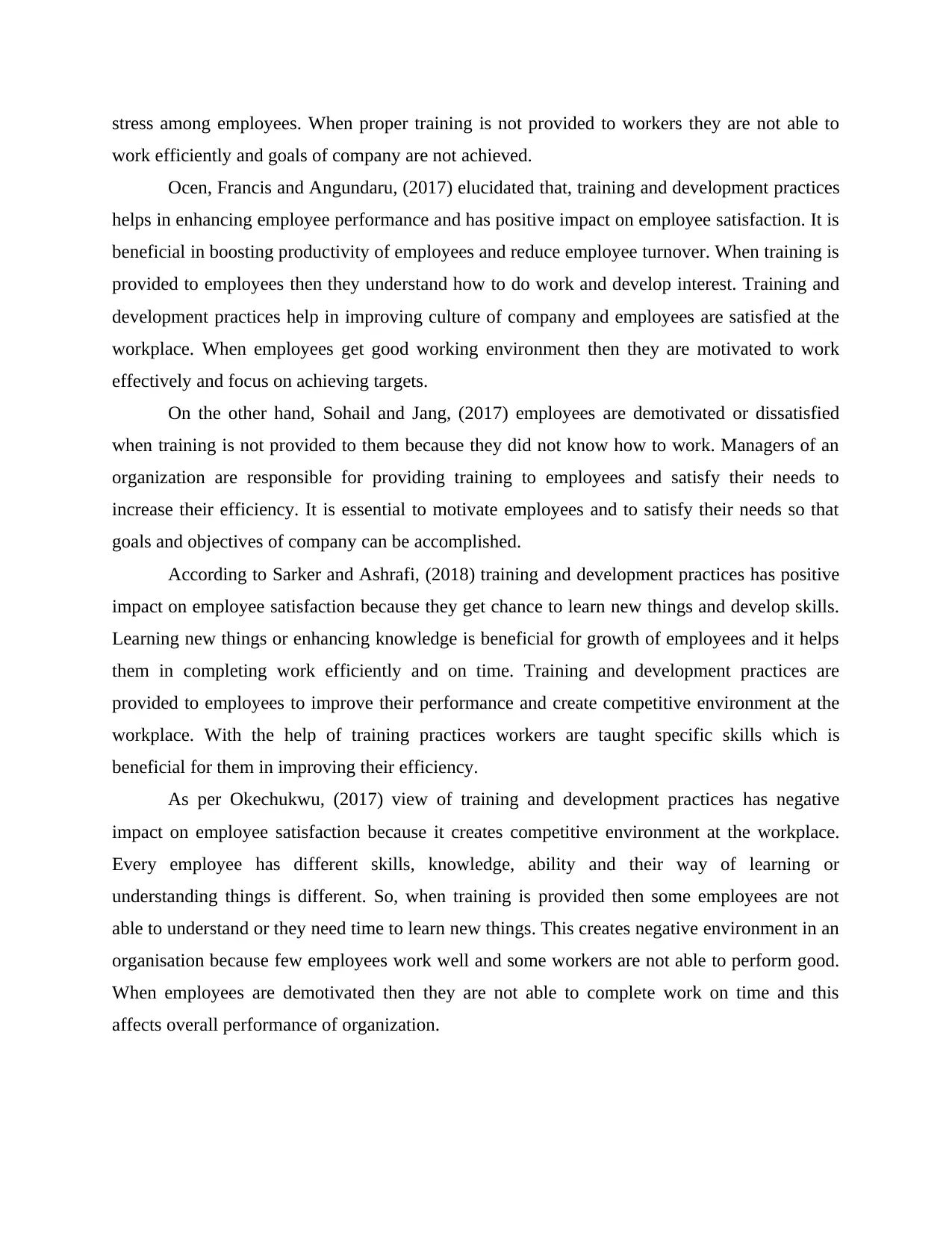
stress among employees. When proper training is not provided to workers they are not able to
work efficiently and goals of company are not achieved.
Ocen, Francis and Angundaru, (2017) elucidated that, training and development practices
helps in enhancing employee performance and has positive impact on employee satisfaction. It is
beneficial in boosting productivity of employees and reduce employee turnover. When training is
provided to employees then they understand how to do work and develop interest. Training and
development practices help in improving culture of company and employees are satisfied at the
workplace. When employees get good working environment then they are motivated to work
effectively and focus on achieving targets.
On the other hand, Sohail and Jang, (2017) employees are demotivated or dissatisfied
when training is not provided to them because they did not know how to work. Managers of an
organization are responsible for providing training to employees and satisfy their needs to
increase their efficiency. It is essential to motivate employees and to satisfy their needs so that
goals and objectives of company can be accomplished.
According to Sarker and Ashrafi, (2018) training and development practices has positive
impact on employee satisfaction because they get chance to learn new things and develop skills.
Learning new things or enhancing knowledge is beneficial for growth of employees and it helps
them in completing work efficiently and on time. Training and development practices are
provided to employees to improve their performance and create competitive environment at the
workplace. With the help of training practices workers are taught specific skills which is
beneficial for them in improving their efficiency.
As per Okechukwu, (2017) view of training and development practices has negative
impact on employee satisfaction because it creates competitive environment at the workplace.
Every employee has different skills, knowledge, ability and their way of learning or
understanding things is different. So, when training is provided then some employees are not
able to understand or they need time to learn new things. This creates negative environment in an
organisation because few employees work well and some workers are not able to perform good.
When employees are demotivated then they are not able to complete work on time and this
affects overall performance of organization.
work efficiently and goals of company are not achieved.
Ocen, Francis and Angundaru, (2017) elucidated that, training and development practices
helps in enhancing employee performance and has positive impact on employee satisfaction. It is
beneficial in boosting productivity of employees and reduce employee turnover. When training is
provided to employees then they understand how to do work and develop interest. Training and
development practices help in improving culture of company and employees are satisfied at the
workplace. When employees get good working environment then they are motivated to work
effectively and focus on achieving targets.
On the other hand, Sohail and Jang, (2017) employees are demotivated or dissatisfied
when training is not provided to them because they did not know how to work. Managers of an
organization are responsible for providing training to employees and satisfy their needs to
increase their efficiency. It is essential to motivate employees and to satisfy their needs so that
goals and objectives of company can be accomplished.
According to Sarker and Ashrafi, (2018) training and development practices has positive
impact on employee satisfaction because they get chance to learn new things and develop skills.
Learning new things or enhancing knowledge is beneficial for growth of employees and it helps
them in completing work efficiently and on time. Training and development practices are
provided to employees to improve their performance and create competitive environment at the
workplace. With the help of training practices workers are taught specific skills which is
beneficial for them in improving their efficiency.
As per Okechukwu, (2017) view of training and development practices has negative
impact on employee satisfaction because it creates competitive environment at the workplace.
Every employee has different skills, knowledge, ability and their way of learning or
understanding things is different. So, when training is provided then some employees are not
able to understand or they need time to learn new things. This creates negative environment in an
organisation because few employees work well and some workers are not able to perform good.
When employees are demotivated then they are not able to complete work on time and this
affects overall performance of organization.
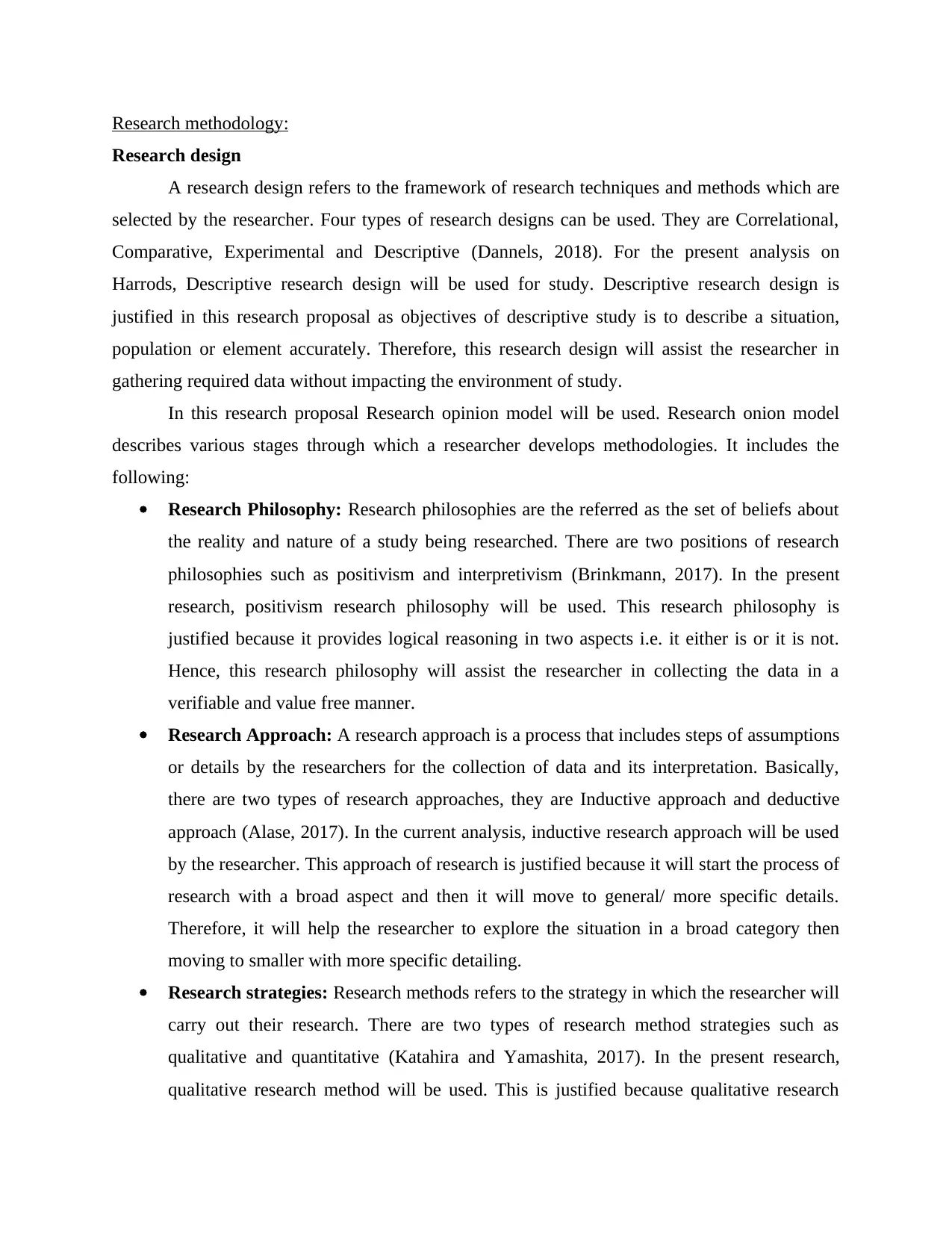
Research methodology:
Research design
A research design refers to the framework of research techniques and methods which are
selected by the researcher. Four types of research designs can be used. They are Correlational,
Comparative, Experimental and Descriptive (Dannels, 2018). For the present analysis on
Harrods, Descriptive research design will be used for study. Descriptive research design is
justified in this research proposal as objectives of descriptive study is to describe a situation,
population or element accurately. Therefore, this research design will assist the researcher in
gathering required data without impacting the environment of study.
In this research proposal Research opinion model will be used. Research onion model
describes various stages through which a researcher develops methodologies. It includes the
following:
Research Philosophy: Research philosophies are the referred as the set of beliefs about
the reality and nature of a study being researched. There are two positions of research
philosophies such as positivism and interpretivism (Brinkmann, 2017). In the present
research, positivism research philosophy will be used. This research philosophy is
justified because it provides logical reasoning in two aspects i.e. it either is or it is not.
Hence, this research philosophy will assist the researcher in collecting the data in a
verifiable and value free manner.
Research Approach: A research approach is a process that includes steps of assumptions
or details by the researchers for the collection of data and its interpretation. Basically,
there are two types of research approaches, they are Inductive approach and deductive
approach (Alase, 2017). In the current analysis, inductive research approach will be used
by the researcher. This approach of research is justified because it will start the process of
research with a broad aspect and then it will move to general/ more specific details.
Therefore, it will help the researcher to explore the situation in a broad category then
moving to smaller with more specific detailing.
Research strategies: Research methods refers to the strategy in which the researcher will
carry out their research. There are two types of research method strategies such as
qualitative and quantitative (Katahira and Yamashita, 2017). In the present research,
qualitative research method will be used. This is justified because qualitative research
Research design
A research design refers to the framework of research techniques and methods which are
selected by the researcher. Four types of research designs can be used. They are Correlational,
Comparative, Experimental and Descriptive (Dannels, 2018). For the present analysis on
Harrods, Descriptive research design will be used for study. Descriptive research design is
justified in this research proposal as objectives of descriptive study is to describe a situation,
population or element accurately. Therefore, this research design will assist the researcher in
gathering required data without impacting the environment of study.
In this research proposal Research opinion model will be used. Research onion model
describes various stages through which a researcher develops methodologies. It includes the
following:
Research Philosophy: Research philosophies are the referred as the set of beliefs about
the reality and nature of a study being researched. There are two positions of research
philosophies such as positivism and interpretivism (Brinkmann, 2017). In the present
research, positivism research philosophy will be used. This research philosophy is
justified because it provides logical reasoning in two aspects i.e. it either is or it is not.
Hence, this research philosophy will assist the researcher in collecting the data in a
verifiable and value free manner.
Research Approach: A research approach is a process that includes steps of assumptions
or details by the researchers for the collection of data and its interpretation. Basically,
there are two types of research approaches, they are Inductive approach and deductive
approach (Alase, 2017). In the current analysis, inductive research approach will be used
by the researcher. This approach of research is justified because it will start the process of
research with a broad aspect and then it will move to general/ more specific details.
Therefore, it will help the researcher to explore the situation in a broad category then
moving to smaller with more specific detailing.
Research strategies: Research methods refers to the strategy in which the researcher will
carry out their research. There are two types of research method strategies such as
qualitative and quantitative (Katahira and Yamashita, 2017). In the present research,
qualitative research method will be used. This is justified because qualitative research
⊘ This is a preview!⊘
Do you want full access?
Subscribe today to unlock all pages.

Trusted by 1+ million students worldwide
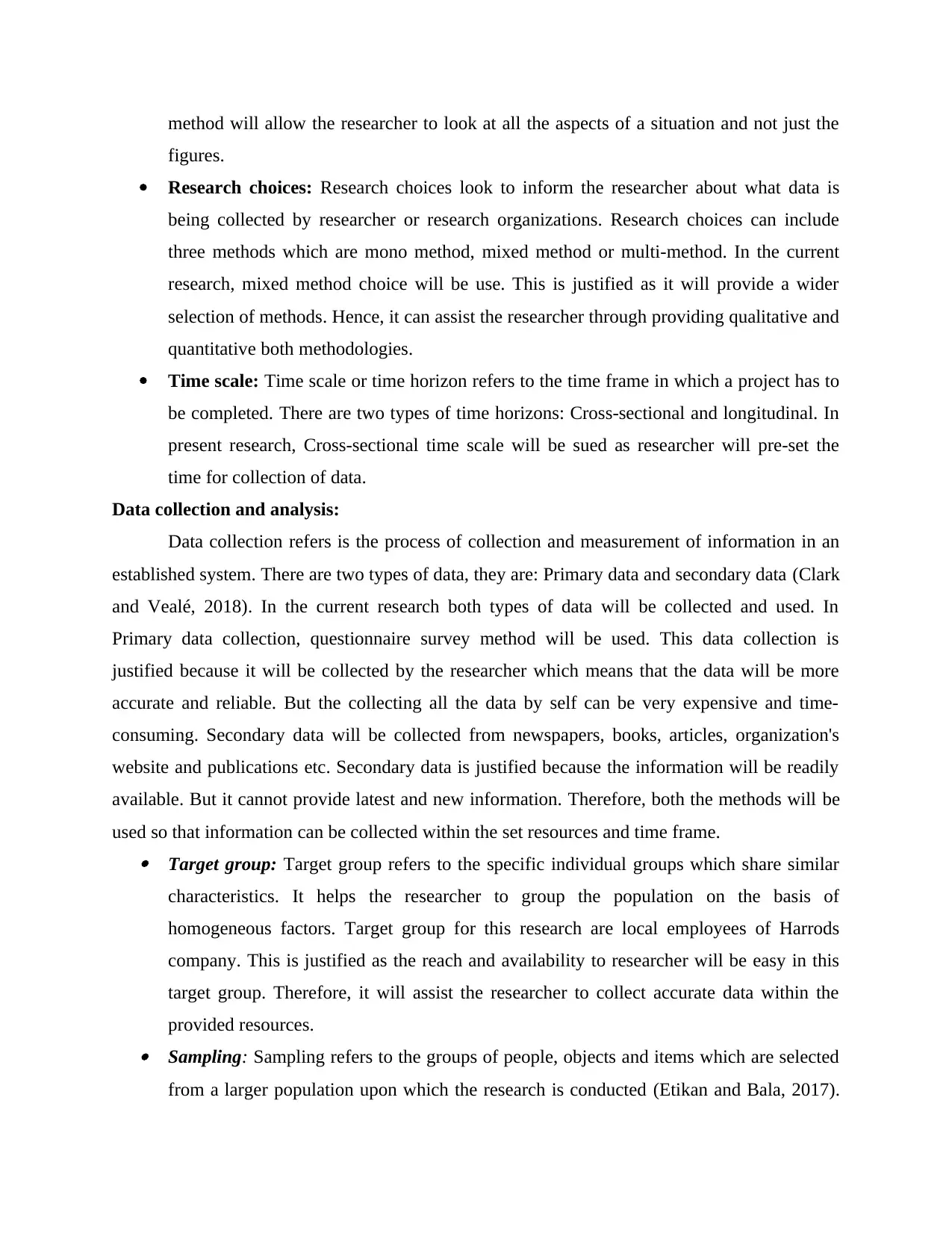
method will allow the researcher to look at all the aspects of a situation and not just the
figures.
Research choices: Research choices look to inform the researcher about what data is
being collected by researcher or research organizations. Research choices can include
three methods which are mono method, mixed method or multi-method. In the current
research, mixed method choice will be use. This is justified as it will provide a wider
selection of methods. Hence, it can assist the researcher through providing qualitative and
quantitative both methodologies.
Time scale: Time scale or time horizon refers to the time frame in which a project has to
be completed. There are two types of time horizons: Cross-sectional and longitudinal. In
present research, Cross-sectional time scale will be sued as researcher will pre-set the
time for collection of data.
Data collection and analysis:
Data collection refers is the process of collection and measurement of information in an
established system. There are two types of data, they are: Primary data and secondary data (Clark
and Vealé, 2018). In the current research both types of data will be collected and used. In
Primary data collection, questionnaire survey method will be used. This data collection is
justified because it will be collected by the researcher which means that the data will be more
accurate and reliable. But the collecting all the data by self can be very expensive and time-
consuming. Secondary data will be collected from newspapers, books, articles, organization's
website and publications etc. Secondary data is justified because the information will be readily
available. But it cannot provide latest and new information. Therefore, both the methods will be
used so that information can be collected within the set resources and time frame. Target group: Target group refers to the specific individual groups which share similar
characteristics. It helps the researcher to group the population on the basis of
homogeneous factors. Target group for this research are local employees of Harrods
company. This is justified as the reach and availability to researcher will be easy in this
target group. Therefore, it will assist the researcher to collect accurate data within the
provided resources. Sampling: Sampling refers to the groups of people, objects and items which are selected
from a larger population upon which the research is conducted (Etikan and Bala, 2017).
figures.
Research choices: Research choices look to inform the researcher about what data is
being collected by researcher or research organizations. Research choices can include
three methods which are mono method, mixed method or multi-method. In the current
research, mixed method choice will be use. This is justified as it will provide a wider
selection of methods. Hence, it can assist the researcher through providing qualitative and
quantitative both methodologies.
Time scale: Time scale or time horizon refers to the time frame in which a project has to
be completed. There are two types of time horizons: Cross-sectional and longitudinal. In
present research, Cross-sectional time scale will be sued as researcher will pre-set the
time for collection of data.
Data collection and analysis:
Data collection refers is the process of collection and measurement of information in an
established system. There are two types of data, they are: Primary data and secondary data (Clark
and Vealé, 2018). In the current research both types of data will be collected and used. In
Primary data collection, questionnaire survey method will be used. This data collection is
justified because it will be collected by the researcher which means that the data will be more
accurate and reliable. But the collecting all the data by self can be very expensive and time-
consuming. Secondary data will be collected from newspapers, books, articles, organization's
website and publications etc. Secondary data is justified because the information will be readily
available. But it cannot provide latest and new information. Therefore, both the methods will be
used so that information can be collected within the set resources and time frame. Target group: Target group refers to the specific individual groups which share similar
characteristics. It helps the researcher to group the population on the basis of
homogeneous factors. Target group for this research are local employees of Harrods
company. This is justified as the reach and availability to researcher will be easy in this
target group. Therefore, it will assist the researcher to collect accurate data within the
provided resources. Sampling: Sampling refers to the groups of people, objects and items which are selected
from a larger population upon which the research is conducted (Etikan and Bala, 2017).
Paraphrase This Document
Need a fresh take? Get an instant paraphrase of this document with our AI Paraphraser
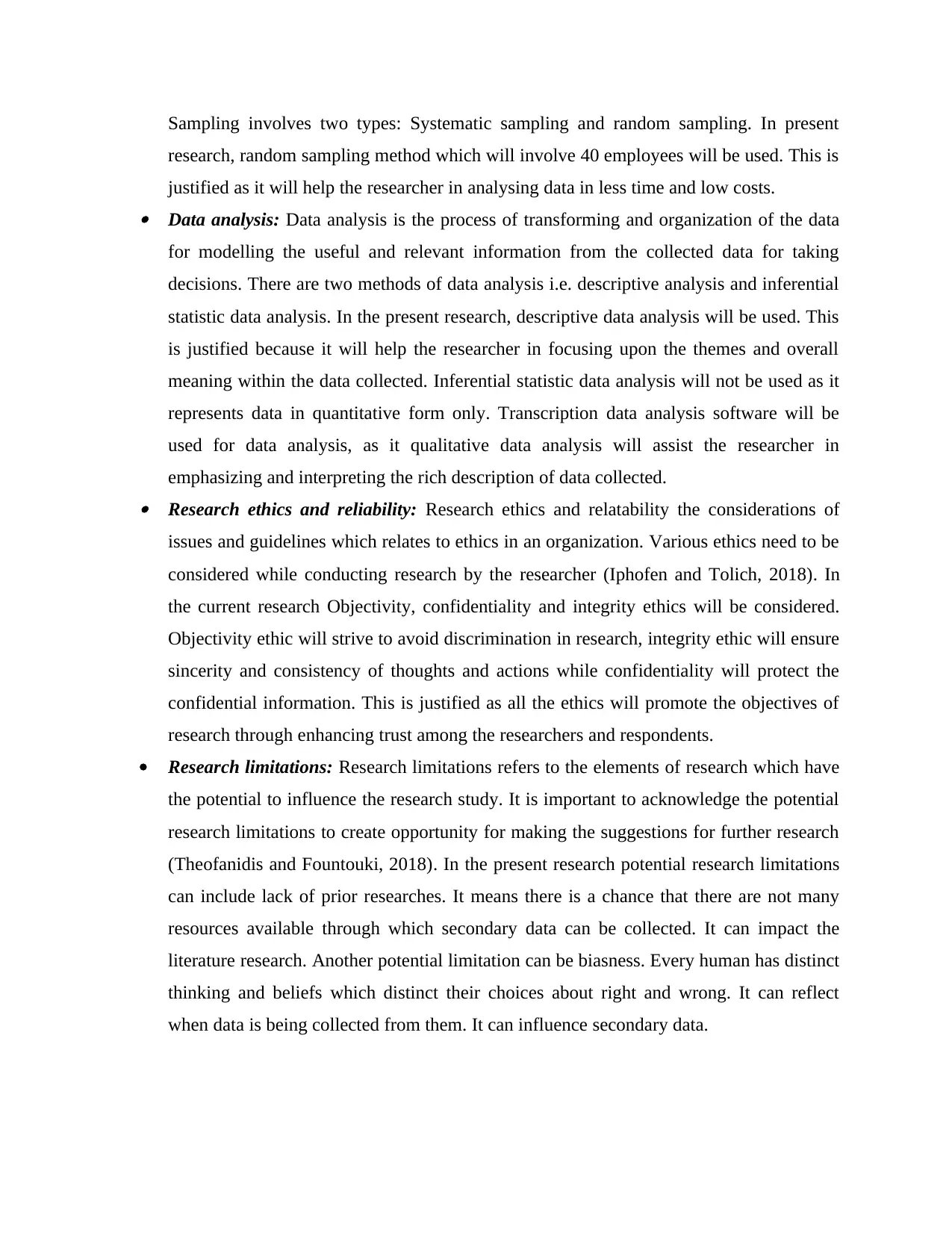
Sampling involves two types: Systematic sampling and random sampling. In present
research, random sampling method which will involve 40 employees will be used. This is
justified as it will help the researcher in analysing data in less time and low costs. Data analysis: Data analysis is the process of transforming and organization of the data
for modelling the useful and relevant information from the collected data for taking
decisions. There are two methods of data analysis i.e. descriptive analysis and inferential
statistic data analysis. In the present research, descriptive data analysis will be used. This
is justified because it will help the researcher in focusing upon the themes and overall
meaning within the data collected. Inferential statistic data analysis will not be used as it
represents data in quantitative form only. Transcription data analysis software will be
used for data analysis, as it qualitative data analysis will assist the researcher in
emphasizing and interpreting the rich description of data collected. Research ethics and reliability: Research ethics and relatability the considerations of
issues and guidelines which relates to ethics in an organization. Various ethics need to be
considered while conducting research by the researcher (Iphofen and Tolich, 2018). In
the current research Objectivity, confidentiality and integrity ethics will be considered.
Objectivity ethic will strive to avoid discrimination in research, integrity ethic will ensure
sincerity and consistency of thoughts and actions while confidentiality will protect the
confidential information. This is justified as all the ethics will promote the objectives of
research through enhancing trust among the researchers and respondents.
Research limitations: Research limitations refers to the elements of research which have
the potential to influence the research study. It is important to acknowledge the potential
research limitations to create opportunity for making the suggestions for further research
(Theofanidis and Fountouki, 2018). In the present research potential research limitations
can include lack of prior researches. It means there is a chance that there are not many
resources available through which secondary data can be collected. It can impact the
literature research. Another potential limitation can be biasness. Every human has distinct
thinking and beliefs which distinct their choices about right and wrong. It can reflect
when data is being collected from them. It can influence secondary data.
research, random sampling method which will involve 40 employees will be used. This is
justified as it will help the researcher in analysing data in less time and low costs. Data analysis: Data analysis is the process of transforming and organization of the data
for modelling the useful and relevant information from the collected data for taking
decisions. There are two methods of data analysis i.e. descriptive analysis and inferential
statistic data analysis. In the present research, descriptive data analysis will be used. This
is justified because it will help the researcher in focusing upon the themes and overall
meaning within the data collected. Inferential statistic data analysis will not be used as it
represents data in quantitative form only. Transcription data analysis software will be
used for data analysis, as it qualitative data analysis will assist the researcher in
emphasizing and interpreting the rich description of data collected. Research ethics and reliability: Research ethics and relatability the considerations of
issues and guidelines which relates to ethics in an organization. Various ethics need to be
considered while conducting research by the researcher (Iphofen and Tolich, 2018). In
the current research Objectivity, confidentiality and integrity ethics will be considered.
Objectivity ethic will strive to avoid discrimination in research, integrity ethic will ensure
sincerity and consistency of thoughts and actions while confidentiality will protect the
confidential information. This is justified as all the ethics will promote the objectives of
research through enhancing trust among the researchers and respondents.
Research limitations: Research limitations refers to the elements of research which have
the potential to influence the research study. It is important to acknowledge the potential
research limitations to create opportunity for making the suggestions for further research
(Theofanidis and Fountouki, 2018). In the present research potential research limitations
can include lack of prior researches. It means there is a chance that there are not many
resources available through which secondary data can be collected. It can impact the
literature research. Another potential limitation can be biasness. Every human has distinct
thinking and beliefs which distinct their choices about right and wrong. It can reflect
when data is being collected from them. It can influence secondary data.
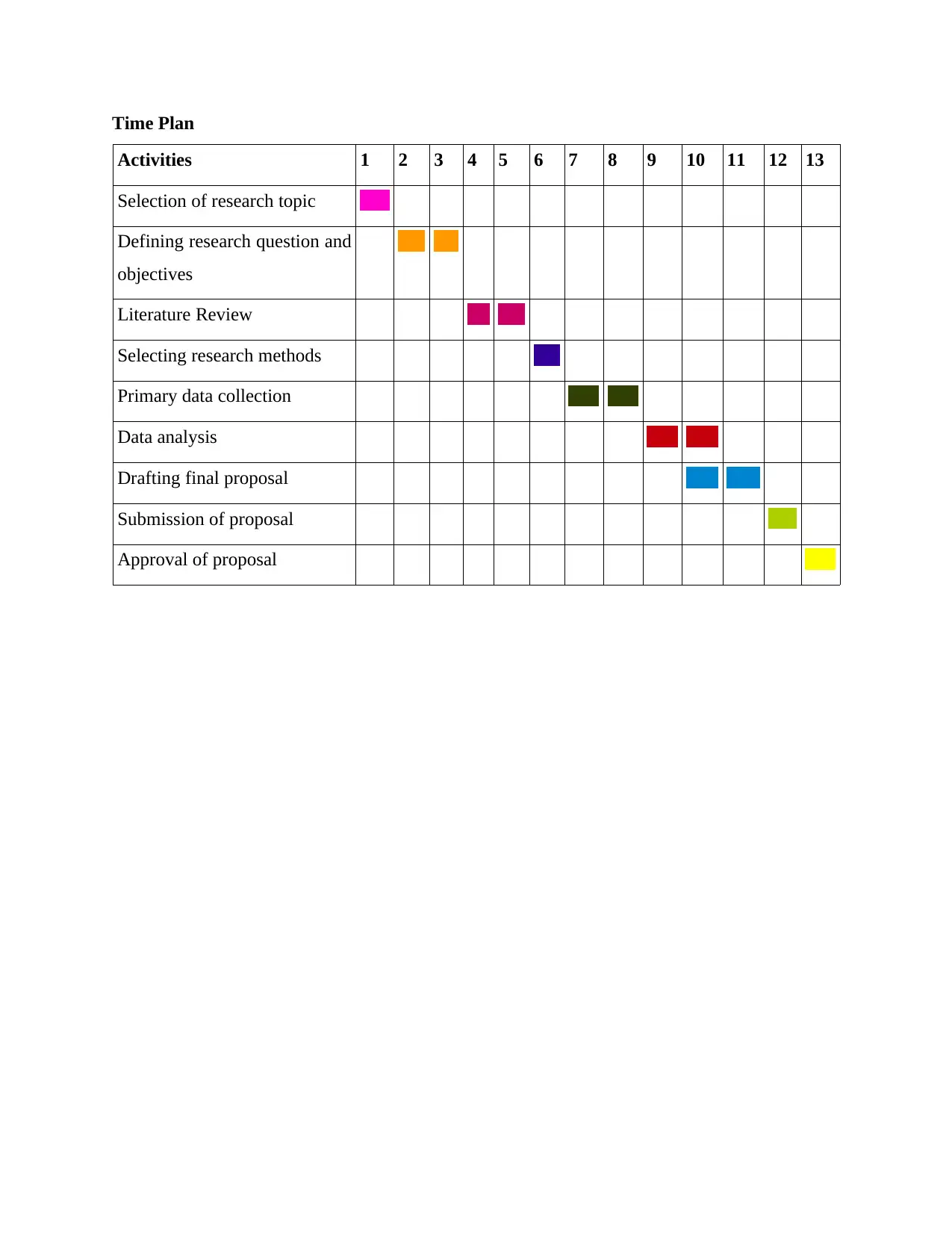
Time Plan
Activities 1 2 3 4 5 6 7 8 9 10 11 12 13
Selection of research topic
Defining research question and
objectives
Literature Review
Selecting research methods
Primary data collection
Data analysis
Drafting final proposal
Submission of proposal
Approval of proposal
Activities 1 2 3 4 5 6 7 8 9 10 11 12 13
Selection of research topic
Defining research question and
objectives
Literature Review
Selecting research methods
Primary data collection
Data analysis
Drafting final proposal
Submission of proposal
Approval of proposal
⊘ This is a preview!⊘
Do you want full access?
Subscribe today to unlock all pages.

Trusted by 1+ million students worldwide
1 out of 14
Related Documents
Your All-in-One AI-Powered Toolkit for Academic Success.
+13062052269
info@desklib.com
Available 24*7 on WhatsApp / Email
![[object Object]](/_next/static/media/star-bottom.7253800d.svg)
Unlock your academic potential
Copyright © 2020–2025 A2Z Services. All Rights Reserved. Developed and managed by ZUCOL.




